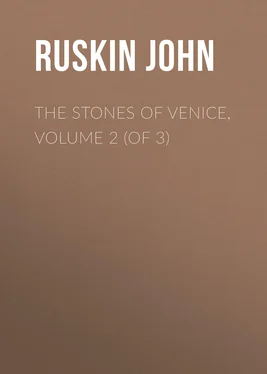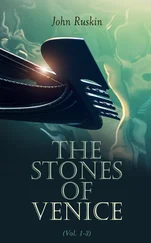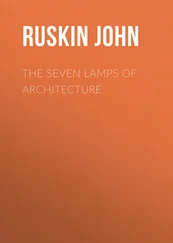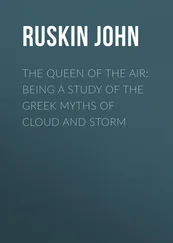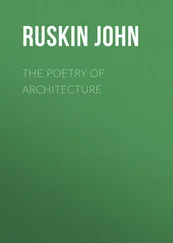John Ruskin - The Stones of Venice, Volume 2 (of 3)
Здесь есть возможность читать онлайн «John Ruskin - The Stones of Venice, Volume 2 (of 3)» — ознакомительный отрывок электронной книги совершенно бесплатно, а после прочтения отрывка купить полную версию. В некоторых случаях можно слушать аудио, скачать через торрент в формате fb2 и присутствует краткое содержание. Жанр: foreign_antique, foreign_home, architecture_book, literature_19, visual_arts, на английском языке. Описание произведения, (предисловие) а так же отзывы посетителей доступны на портале библиотеки ЛибКат.
- Название:The Stones of Venice, Volume 2 (of 3)
- Автор:
- Жанр:
- Год:неизвестен
- ISBN:нет данных
- Рейтинг книги:5 / 5. Голосов: 1
-
Избранное:Добавить в избранное
- Отзывы:
-
Ваша оценка:
- 100
- 1
- 2
- 3
- 4
- 5
The Stones of Venice, Volume 2 (of 3): краткое содержание, описание и аннотация
Предлагаем к чтению аннотацию, описание, краткое содержание или предисловие (зависит от того, что написал сам автор книги «The Stones of Venice, Volume 2 (of 3)»). Если вы не нашли необходимую информацию о книге — напишите в комментариях, мы постараемся отыскать её.
The Stones of Venice, Volume 2 (of 3) — читать онлайн ознакомительный отрывок
Ниже представлен текст книги, разбитый по страницам. Система сохранения места последней прочитанной страницы, позволяет с удобством читать онлайн бесплатно книгу «The Stones of Venice, Volume 2 (of 3)», без необходимости каждый раз заново искать на чём Вы остановились. Поставьте закладку, и сможете в любой момент перейти на страницу, на которой закончили чтение.
Интервал:
Закладка:
§ VII. It stands, it and the heavy campanile detached from it a few yards, in a small triangular field of somewhat fresher grass than is usual near Venice, traversed by a paved walk with green mosaic of short grass between the rude squares of its stones, bounded on one side by ruinous garden walls, on another by a line of low cottages, on the third, the base of the triangle, by the shallow canal from which we have just landed. Near the point of the triangular space is a simple well, bearing date 1502; in its widest part, between the canal and campanile, is a four-square hollow pillar, each side formed by a separate slab of stone, to which the iron hasps are still attached that once secured the Venetian standard.
The cathedral itself occupies the northern angle of the field, encumbered with modern buildings, small outhouse-like chapels, and wastes of white wall with blank square windows, and itself utterly defaced in the whole body of it, nothing but the apse having been spared; the original plan is only discoverable by careful examination, and even then but partially. The whole impression and effect of the building are irretrievably lost, but the fragments of it are still most precious.
We must first briefly state what is known of its history.
§ VIII. The legends of the Romish Church, though generally more insipid and less varied than those of Paganism, deserve audience from us on this ground, if on no other, that they have once been sincerely believed by good men, and have had no ineffective agency in the foundation of the existent European mind. The reader must not therefore accuse me of trifling, when I record for him the first piece of information I have been able to collect respecting the cathedral of Murano: namely, that the emperor Otho the Great, being overtaken by a storm on the Adriatic, vowed, if he were preserved, to build and dedicate a church to the Virgin, in whatever place might be most pleasing to her; that the storm thereupon abated; and the Virgin appearing to Otho in a dream showed him, covered with red lilies, that very triangular field on which we were but now standing, amidst the ragged weeds and shattered pavement. The emperor obeyed the vision; and the church was consecrated on the 15th of August, 957.
§ IX. Whatever degree of credence we may feel disposed to attach to this piece of history, there is no question that a church was built on this spot before the close of the tenth century: since in the year 999 we find the incumbent of the Basilica (note this word, it is of some importance) di Santa Maria Plebania di Murano taking an oath of obedience to the Bishop of the Altinat church, and engaging at the same time to give the said bishop his dinner on the Domenica in Albis, when the prelate held a confirmation in the mother church, as it was then commonly called, of Murano. From this period, for more than a century, I can find no records of any alterations made in the fabric of the church, but there exist very full details of the quarrels which arose between its incumbents and those of San Stefano, San Cipriano, San Salvatore, and the other churches of Murano, touching the due obedience which their less numerous or less ancient brotherhoods owed to St. Mary’s.
These differences seem to have been renewed at the election of every new abbot by each of the fraternities, and must have been growing serious when the patriarch of Grado, Henry Dandolo, interfered in 1102, and, in order to seal a peace between the two principal opponents, ordered that the abbot of St. Stephen’s should be present at the service in St. Mary’s on the night of the Epiphany, and that the abbot of St. Mary’s should visit him of St. Stephen’s on St. Stephen’s day; and that then the two abbots “should eat apples and drink good wine together, in peace and charity.” 10
§ X. But even this kindly effort seems to have been without result: the irritated pride of the antagonists remained unsoothed by the love-feast of St. Stephen’s day; and the breach continued to widen until the abbot of St. Mary’s obtained a timely accession to his authority in the year 1125. The Doge Domenico Michele, having in the second crusade secured such substantial advantages for the Venetians as might well counterbalance the loss of part of their trade with the East, crowned his successes by obtaining possession in Cephalonia of the body of St. Donato, bishop of Eurœa; which treasure he having presented on his return to the Murano basilica, that church was thenceforward called the church of Sts. Mary and Donato. Nor was the body of the saint its only acquisition: St. Donato’s principal achievement had been the destruction of a terrible dragon in Epirus; Michele brought home the bones of the dragon as well as of the saint; the latter were put in a marble sarcophagus, and the former hung up over the high altar.
§ XI. But the clergy of St. Stefano were indomitable. At the very moment when their adversaries had received this formidable accession of strength, they had the audacity “ad onta de’ replicati giuramenti, e dell’inveterata consuetudine,” 11to refuse to continue in the obedience which they had vowed to their mother church. The matter was tried in a provincial council; the votaries of St. Stephen were condemned, and remained quiet for about twenty years, in wholesome dread of the authority conferred on the abbot of St. Donate, by the Pope’s legate, to suspend any o the clergy of the island from their office if they refused submission. In 1172, however, they appealed to Pope Alexander III, and were condemned again: and we find the struggle renewed at every promising opportunity, during the course of the 12th and 13th centuries; until at last, finding St. Donate and the dragon together too strong for him, the abbot of St. Stefano “discovered” in his church the bodies of two hundred martyrs at once!—a discovery, it is to be remembered, in some sort equivalent in those days to that of California in ours. The inscription, however, on the façade of the church, recorded it with quiet dignity:– “MCCCLXXIV. a di XIV. di Aprile. Furono trovati nella presente chiesa del protomartire San Stefano, duecento e più corpi de’ Santi Martiri, dal Ven. Prete Matteo Fradello, piovano della chiesa.” 12Corner, who gives this inscription, which no longer exists, goes on to explain with infinite gravity, that the bodies in question, “being of infantile form and stature, are reported by tradition to have belonged to those fortunate innocents who suffered martyrdom under King Herod; but that when, or by whom, the church was enriched with so vast a treasure, is not manifested by any document.” 13
§ XII. The issue of the struggle is not to our present purpose. We have already arrived at the fourteenth century without finding record of any effort made by the clergy of St. Mary’s to maintain their influence by restoring or beautifying their basilica; which is the only point at present of importance to us. That great alterations were made in it at the time of the acquisition of the body of St. Donato is however highly probable, the mosaic pavement of the interior, which bears its date inscribed, 1140, being probably the last of the additions. I believe that no part of the ancient church can be shown to be of more recent date than this; and I shall not occupy the reader’s time by any inquiry respecting the epochs or authors of the destructive modern restorations; the wreck of the old fabric, breaking out beneath them here and there, is generally distinguishable from them at a glance; and it is enough for the reader to know that none of these truly ancient fragments can be assigned to a more recent date than 1140, and that some of them may with probability be looked upon as remains of the shell of the first church, erected in the course of the latter half of the tenth century. We shall perhaps obtain some further reason for this belief as we examine these remains themselves.
Читать дальшеИнтервал:
Закладка:
Похожие книги на «The Stones of Venice, Volume 2 (of 3)»
Представляем Вашему вниманию похожие книги на «The Stones of Venice, Volume 2 (of 3)» списком для выбора. Мы отобрали схожую по названию и смыслу литературу в надежде предоставить читателям больше вариантов отыскать новые, интересные, ещё непрочитанные произведения.
Обсуждение, отзывы о книге «The Stones of Venice, Volume 2 (of 3)» и просто собственные мнения читателей. Оставьте ваши комментарии, напишите, что Вы думаете о произведении, его смысле или главных героях. Укажите что конкретно понравилось, а что нет, и почему Вы так считаете.
